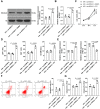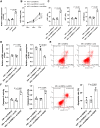Epigenetic modification mechanism of histone demethylase KDM1A in regulating cardiomyocyte apoptosis after myocardial ischemia-reperfusion injury
- PMID: 35959481
- PMCID: PMC9359132
- DOI: 10.7717/peerj.13823
Epigenetic modification mechanism of histone demethylase KDM1A in regulating cardiomyocyte apoptosis after myocardial ischemia-reperfusion injury
Abstract
Hypoxia and reoxygenation (H/R) play a prevalent role in heart-related diseases. Histone demethylases are involved in myocardial injury. In this study, the mechanism of the lysine-specific histone demethylase 1A (KDM1A/LSD1) on cardiomyocyte apoptosis after myocardial ischemia-reperfusion injury (MIRI) was investigated. Firstly, HL-1 cells were treated with H/R to establish the MIRI models. The expressions of KDM1A and Sex Determining Region Y-Box Transcription Factor 9 (SOX9) in H/R-treated HL-1 cells were examined. The cell viability, markers of myocardial injury (LDH, AST, and CK-MB) and apoptosis (Bax and Bcl-2), and Caspase-3 and Caspase-9 protein activities were detected, respectively. We found that H/R treatment promoted cardiomyocyte apoptosis and downregulated KDM1A, and overexpressing KDM1A reduced apoptosis in H/R-treated cardiomyocytes. Subsequently, tri-methylation of lysine 4 on histone H3 (H3K4me3) level on the SOX9 promoter region was detected. We found that KDM1A repressed SOX9 transcription by reducing H3K4me3. Then, HL-1 cells were treated with CPI-455 and plasmid pcDNA3.1-SOX9 and had joint experiments with pcDNA3.1-KDM1A. We disclosed that upregulating H3K4me3 or overexpressing SOX9 reversed the inhibitory effect of overexpressing KDM1A on apoptosis of H/R-treated cardiomyocytes. In conclusion, KDM1A inhibited SOX9 transcription by reducing the H3K4me3 on the SOX9 promoter region and thus inhibited H/R-induced apoptosis of cardiomyocytes.
Keywords: Bax; Bcl-2; Cardiomyocyte apoptosis; H3K4me3; Histone demethylation; Hypoxia-reoxygenation; KDM1A; SOX9.
©2022 He et al.
Conflict of interest statement
The authors declare there are no competing interests.
Figures





Similar articles
-
microRNA-30e up-regulation alleviates myocardial ischemia-reperfusion injury and promotes ventricular remodeling via SOX9 repression.Mol Immunol. 2021 Feb;130:96-103. doi: 10.1016/j.molimm.2020.11.009. Epub 2020 Dec 5. Mol Immunol. 2021. PMID: 33293097
-
Crosstalk between lysine methylation and phosphorylation of ATG16L1 dictates the apoptosis of hypoxia/reoxygenation-induced cardiomyocytes.Autophagy. 2018;14(5):825-844. doi: 10.1080/15548627.2017.1389357. Epub 2018 Apr 10. Autophagy. 2018. PMID: 29634390 Free PMC article.
-
The histone demthylase KDM3A protects the myocardium from ischemia/reperfusion injury via promotion of ETS1 expression.Commun Biol. 2022 Mar 25;5(1):270. doi: 10.1038/s42003-022-03225-y. Commun Biol. 2022. PMID: 35338235 Free PMC article.
-
Histone methyl-transferases and demethylases in the autophagy regulatory network: the emerging role of KDM1A/LSD1 demethylase.Autophagy. 2019 Feb;15(2):187-196. doi: 10.1080/15548627.2018.1520546. Epub 2018 Sep 22. Autophagy. 2019. PMID: 30208749 Free PMC article. Review.
-
KDM1A microenvironment, its oncogenic potential, and therapeutic significance.Epigenetics Chromatin. 2018 Jun 19;11(1):33. doi: 10.1186/s13072-018-0203-3. Epigenetics Chromatin. 2018. PMID: 29921310 Free PMC article. Review.
Cited by
-
Role and research progress of histone modification in cardiovascular diseases (Review).Exp Ther Med. 2025 May 13;30(1):132. doi: 10.3892/etm.2025.12882. eCollection 2025 Jul. Exp Ther Med. 2025. PMID: 40421232 Free PMC article. Review.
-
Programmed cardiomyocyte death in myocardial infarction.Apoptosis. 2025 Apr;30(3-4):597-615. doi: 10.1007/s10495-025-02075-3. Epub 2025 Jan 20. Apoptosis. 2025. PMID: 39833636 Review.
References
-
- Chen Z, Guo W, Wu Q, Tan L, Ma T, Fu C, Yu J, Ren X, Wang J, Liang P, Meng X. Tumor reoxygenation for enhanced combination of radiation therapy and microwave thermal therapy using oxygen generation in situ by CuO nanosuperparticles under microwave irradiation. Theranostics. 2020;10(10):4659–4675. doi: 10.7150/thno.42818. - DOI - PMC - PubMed
MeSH terms
Substances
LinkOut - more resources
Full Text Sources
Research Materials
Miscellaneous

